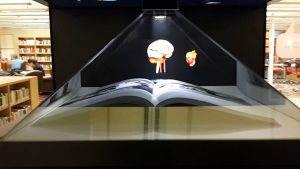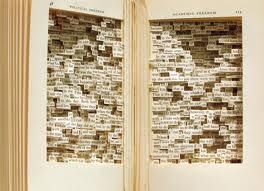“The book as object, as content, as idea, as interface.” (Borsuk)
Picture it…Portland Oregon. It is the year 2050. We are beyond handheld mobile devices and are in a world of wearables. Audio books have been flourishing for decades but sadly, the physical form of a book has far evolved to more than a spine, two covers, and a handful of pages. Bookstores are few and far between. Libraries are now digital spaces that have saved the government valuable financial resources. Time to go down memory lane. Like Blockbuster, Barnes and Nobel is only but nostalgia to those who crave the touch and smell of a paper bound book. It is the world of portals for inside a bookstore draws in those curious of its endless knowledge between a cover sleeve. Digital readers continue to sell here but this space was made for those who relish the ambient light, soft music, and dark academia theme décor. A physical book meant solitude. A bit of peace from the outside world. An intimate relationship with the protagonist or antagonist of the story. A profound narrative in real time that pulls you from space to space. This was a book. Paper between two covers and a spine.
“From scroll to bound folio, books have indeed evolved. And like all things subject to evolution, they can face extinction.” -Garrett Stewart (Borsuk)
The book as a codex is no longer a physical device. Now it’s a projection of light and sound waves that convey digital content. Pixels form on a desk from a ring. The projection of pixels is now able to be manipulated like that of touchscreen but with no glass. It can be zoomed into or zoomed out of. Words can be animated and still legible. Letterforms go from left to right, top to bottom but in a continuous motion. Like a new age tickertape. 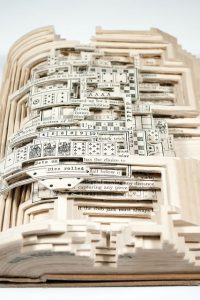 Products of our generation, the digital pages are condensed and easier to read. Since going digital, social media has taken the publishing world by storm. Digital books contain marginalia with real time commentary and dictation. The author is kept up to date on the progression of his/her works. It is even offered into the interface, the ability to add multiple endings. Such as those that you notice on a DVD menu. The alternative endings are to drive more discussion and communication about the timeline of events. Accessibility for digital books is also turning from audio with an option for interactive raised braille. The screen then morphs texture into the device itself.
Products of our generation, the digital pages are condensed and easier to read. Since going digital, social media has taken the publishing world by storm. Digital books contain marginalia with real time commentary and dictation. The author is kept up to date on the progression of his/her works. It is even offered into the interface, the ability to add multiple endings. Such as those that you notice on a DVD menu. The alternative endings are to drive more discussion and communication about the timeline of events. Accessibility for digital books is also turning from audio with an option for interactive raised braille. The screen then morphs texture into the device itself.
Modern wearables now come with book features. A book now looks and feels like a pair of glasses with audio or jewelry able to project its content onto a surface. A sleeve that functions as memory device that plays on acupressure points from the heart channel which in eastern medicine runs the side of the arm down to the pinky. 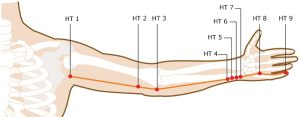 Words are not merely printed but are able to act on brain chemistry by means of certain frequencies that cause the brain to better enhance long-term memory. That frequency of 40 Hz correlates to better understanding of content. (Friedrich et al.) Using digital age technology, knowledge is then retained avoiding the dreaded “data dump” some may experience after reading extensive digital works. The brain receives content faster than ever before thus opening the possibility of leaning new languages. As far as text appearing, language and dialogue have changed due to the new publishing of content. The speed at which one retains the knowledge has allowed new languages to be understood. Being multilingual is now common and literacy is universal. Digital means of study are now available in every corner of the world.
Words are not merely printed but are able to act on brain chemistry by means of certain frequencies that cause the brain to better enhance long-term memory. That frequency of 40 Hz correlates to better understanding of content. (Friedrich et al.) Using digital age technology, knowledge is then retained avoiding the dreaded “data dump” some may experience after reading extensive digital works. The brain receives content faster than ever before thus opening the possibility of leaning new languages. As far as text appearing, language and dialogue have changed due to the new publishing of content. The speed at which one retains the knowledge has allowed new languages to be understood. Being multilingual is now common and literacy is universal. Digital means of study are now available in every corner of the world.
After wearables, we discuss the physicality of a common E-reader device. The physical dimensions of E-readers back then were 6.9 × 4.9 × 0.32 in. Today, the ones that are not embedded into clothing are a common size of paper being 8 ½ “x 11” and sport a virtual keyboard display below the device on any hard surface. This size is beneficial to the social community interacting with the book. Digital screens are only growing larger and thinner every year. With that said, you can fold the device in half to accommodate mobility for the people whose purpose is portability. Speakers are located on both sides with the option for Bluetooth connection. Wi-Fi is enabled for connecting within the book. Memberships are offered to the audience through publishing companies that facilitate the content. More on this later but as we dive into the software contained in the device, we need to make sure the integrity of the book is not compromised. Books are not meant to fade into oblivion. They are treasures and should be treated as such.
“We will also consider contemporary approaches to digital reading that, rather than offering up a crystal goblet, invite us to trace our finger along text’s rim and make it sing: drawing attention to the interface to explore and exploit the affordance of the digital.” (Borsuk)
The world of an e-reader has evolved with smart technology. Think of a student. Like most of us, we rarely have the time to read for pleasure. What we read is often driven by our studies. Some of that time consumed by reading is also trying to absorb the text. Flashcards, notes, and memorization tools gather the purpose of why we read which is to learn. Introducing the reader device that now provides audio reading of the text. While it is reading the text, words are being highlighted for visual stimulation. After the reader completes the book, automatic spark notes are made available to review the material. 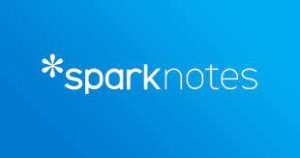 This immersive reading provides the reader with an experience that goes beyond the codex. The book itself can be a momentous feat. There are individuals who simply can’t stay awake to read or are engaged in other activities but need to finish a book fast. This immersive reading experience solves those problems. Another wave of technology has brought short mini scene animations to children’s books. The words are read and highlighted on the screen much like earlier technology, but the audience has short scenes to go along with the story. This also opens a whole new job market for artists and storytellers alike. Much different than film or tv series but shorts that last thirty to sixty seconds.
This immersive reading provides the reader with an experience that goes beyond the codex. The book itself can be a momentous feat. There are individuals who simply can’t stay awake to read or are engaged in other activities but need to finish a book fast. This immersive reading experience solves those problems. Another wave of technology has brought short mini scene animations to children’s books. The words are read and highlighted on the screen much like earlier technology, but the audience has short scenes to go along with the story. This also opens a whole new job market for artists and storytellers alike. Much different than film or tv series but shorts that last thirty to sixty seconds.
In these changing times, publishers are those digital content creators that collaborate with other artists and sites to get the readership up and running. The publishers that served thirty years prior are those that filtrate the material in the margins of the e-reader. They host discussions based on the popularity of certain topics and pre-moderate the content within the spaces of reader interaction. Content moderation is done in house or artificial intelligence based. In house would cost more than AI based but is also there to stimulate and inspire ideas from those who know the book best. 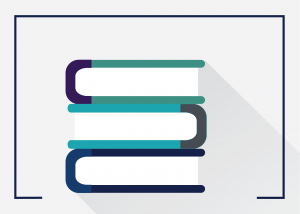 Discussions can be in the form of a question then move into real time chat. The interface is multifunctional giving the audience the benefit of having a book club right inside the screen.
Discussions can be in the form of a question then move into real time chat. The interface is multifunctional giving the audience the benefit of having a book club right inside the screen.
SCI FI BRAKE CHECK
The world is ever changing. Your health is of the utmost importance. You have tried and trusted the wearable devices that have made your life simple. You have experienced virtual reality and that of an E-readers immersive, smart, and active technology. You have seen the hologram images come out of the codex. Now science has come forward with evidence proving that blue light and radiation from these technologies is causing a decline in sight. Therefore, rejection of these technologies is imminent. The movement is profoundly changing the digital wearable future back into a physical art form using the beauty of the codex. Pages are now 3d. Holographic images are built inside “the book” coming from the spine. The covers now fold outwards to reveal art scenes from the story. Summaries are QR codes found on the sleeve. Future generations now come with much appreciation for the workmanship behind the codex and page turning is back on trend.
Ulises Carrion says, “A book is a sequence of spaces. Each of these spaces is perceived at a different moment-a book is also a sequence of moments. A book is not a case of words, nor a bag of words, nor a bearer of words.” (Borsuk) This only proves that a book is ever changing. It has come a long way from a cuneiform tablet to scrolls, from scrolls to codex, from codex to E-reader. Each device has its way of embedding itself into the culture of the period in which it was created. The author drives its narrative by ways of the medium it chooses. Today’s society craves technology that makes life more simplistic and more entertaining. The wave of knowledge must get easier to digest or absorb as time goes on. With falling literacy rates, reader tech must enhance learning devices to cater to its audience. We must fight to maintain the integrity of the book but have options to move forward in the not-so-distant future.
Works Cited
Borsuk, Amaranth. The Book (the MIT Press Essential Knowledge Series). Illustrated, The MIT Press, 2018.
Friedrich, Wernher, et al. “Studying Frequency Processing of the Brain to Enhance Long-term Memory and Develop a Human Brain Protocol.” Technology and Health Care, edited by Edward J. Ciaccio, vol. 23, no. s2, IOS Press, June 2015, pp. S465–71. https://doi.org/10.3233/thc-150983.


